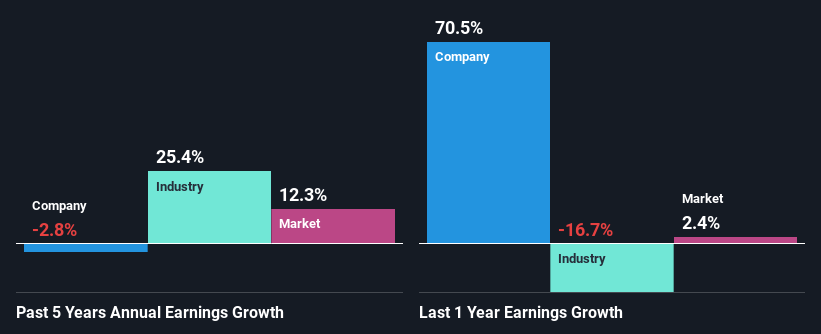Hup Seng Industries Berhad (KLSE:HUPSENG) Stock Is Going Strong But Fundamentals Look Uncertain: What Lies Ahead ?
Hup Seng Industries Berhad (KLSE:HUPSENG) has had a great run on the share market with its stock up by a significant 6.0% over the last month. However, we wonder if the company's inconsistent financials would have any adverse impact on the current share price momentum. Specifically, we decided to study Hup Seng Industries Berhad's ROE in this article.
Return on Equity or ROE is a test of how effectively a company is growing its value and managing investors’ money. In short, ROE shows the profit each dollar generates with respect to its shareholder investments.
Check out our latest analysis for Hup Seng Industries Berhad
How Do You Calculate Return On Equity?
The formula for ROE is:
Return on Equity = Net Profit (from continuing operations) ÷ Shareholders' Equity
So, based on the above formula, the ROE for Hup Seng Industries Berhad is:
31% = RM49m ÷ RM160m (Based on the trailing twelve months to March 2024).
The 'return' is the profit over the last twelve months. That means that for every MYR1 worth of shareholders' equity, the company generated MYR0.31 in profit.
What Has ROE Got To Do With Earnings Growth?
We have already established that ROE serves as an efficient profit-generating gauge for a company's future earnings. Depending on how much of these profits the company reinvests or "retains", and how effectively it does so, we are then able to assess a company’s earnings growth potential. Assuming everything else remains unchanged, the higher the ROE and profit retention, the higher the growth rate of a company compared to companies that don't necessarily bear these characteristics.
A Side By Side comparison of Hup Seng Industries Berhad's Earnings Growth And 31% ROE
Firstly, we acknowledge that Hup Seng Industries Berhad has a significantly high ROE. Secondly, even when compared to the industry average of 7.5% the company's ROE is quite impressive. Needless to say, we are quite surprised to see that Hup Seng Industries Berhad's net income shrunk at a rate of 2.8% over the past five years. Based on this, we feel that there might be other reasons which haven't been discussed so far in this article that could be hampering the company's growth. These include low earnings retention or poor allocation of capital.
However, when we compared Hup Seng Industries Berhad's growth with the industry we found that while the company's earnings have been shrinking, the industry has seen an earnings growth of 25% in the same period. This is quite worrisome.
Earnings growth is an important metric to consider when valuing a stock. It’s important for an investor to know whether the market has priced in the company's expected earnings growth (or decline). This then helps them determine if the stock is placed for a bright or bleak future. Is Hup Seng Industries Berhad fairly valued compared to other companies? These 3 valuation measures might help you decide.
Is Hup Seng Industries Berhad Efficiently Re-investing Its Profits?
With a high three-year median payout ratio of 92% (implying that 8.0% of the profits are retained), most of Hup Seng Industries Berhad's profits are being paid to shareholders, which explains the company's shrinking earnings. The business is only left with a small pool of capital to reinvest - A vicious cycle that doesn't benefit the company in the long-run.
Additionally, Hup Seng Industries Berhad has paid dividends over a period of at least ten years, which means that the company's management is determined to pay dividends even if it means little to no earnings growth. Based on the latest analysts' estimates, we found that the company's future payout ratio over the next three years is expected to hold steady at 74%.
Conclusion
Overall, we have mixed feelings about Hup Seng Industries Berhad. While the company does have a high rate of return, its low earnings retention is probably what's hampering its earnings growth. With that said, we studied the latest analyst forecasts and found that while the company has shrunk its earnings in the past, analysts expect its earnings to grow in the future. To know more about the latest analysts predictions for the company, check out this visualization of analyst forecasts for the company.
Have feedback on this article? Concerned about the content? Get in touch with us directly. Alternatively, email editorial-team (at) simplywallst.com.
This article by Simply Wall St is general in nature. We provide commentary based on historical data and analyst forecasts only using an unbiased methodology and our articles are not intended to be financial advice. It does not constitute a recommendation to buy or sell any stock, and does not take account of your objectives, or your financial situation. We aim to bring you long-term focused analysis driven by fundamental data. Note that our analysis may not factor in the latest price-sensitive company announcements or qualitative material. Simply Wall St has no position in any stocks mentioned.

 Yahoo Finance
Yahoo Finance 
